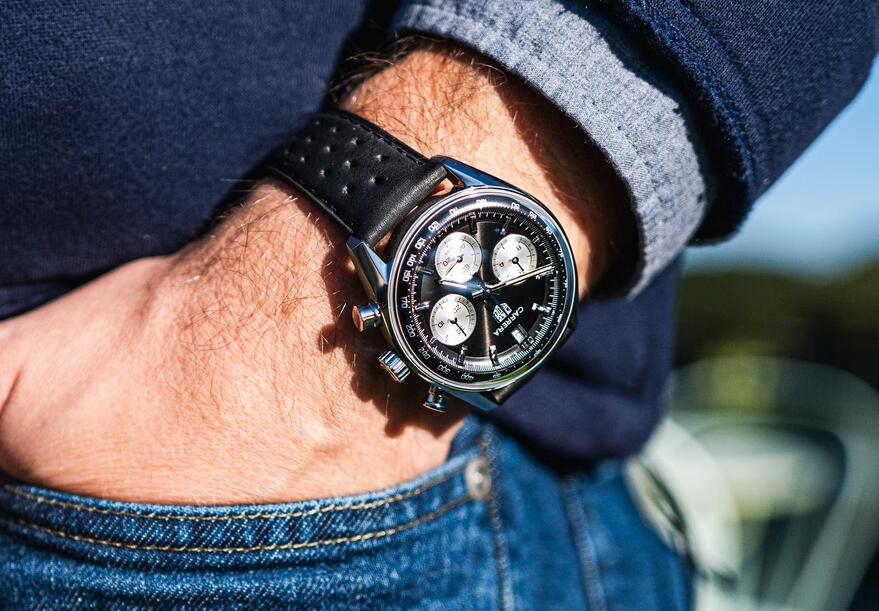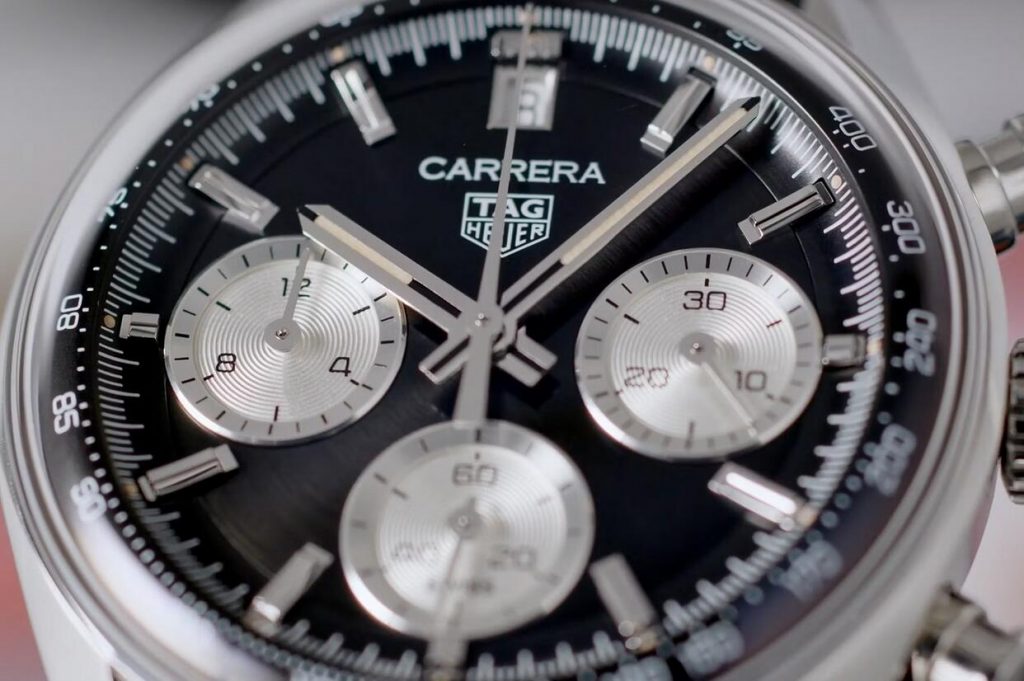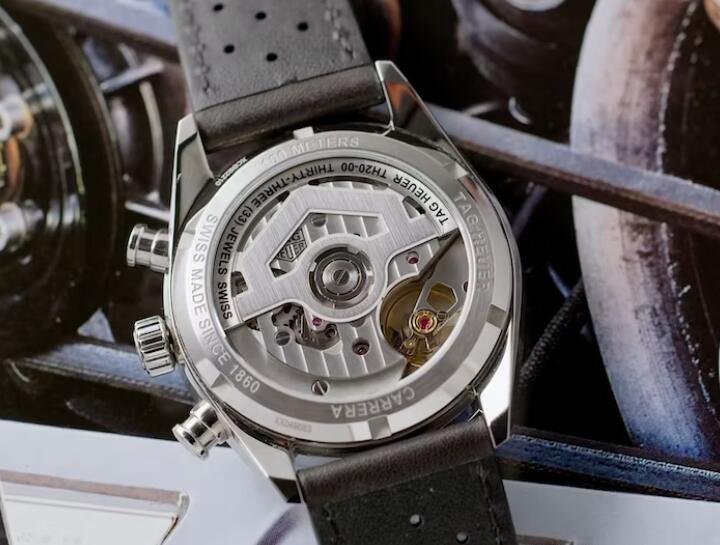TAG Heuer is one of the most recognized watch brands around. But it’s fallen out of favor with watch enthusiasts over the years. That may have changed this year with the release of the 1:1 Swiss replica TAG Heuer Carrera “Glassbox” watches in 39mm. It’s even been called the best TAG Heuer in years. As a long-time lover of the Carrera – I’ve owned a couple of vintage ones over the years – I wanted to spend a week with it on my wrist to see if it lives up to the praise.
On the surface, it’s a well-sized, modern high quality fake watches that pulls on Heuer’s heritage without overdoing it. But I wanted to dig deeper into the Carrera Glassbox to see what it’s all about, and what it might mean for the direction of TAG Heuer. This is A Week On The Wrist with the new, black TAG Heuer Carrera Glassbox in 39mm.

The updated cheap UK replica TAG Heuer Carrera “Glassbox” watches has a 39mm diameter, measures 46mm lug-to-lug, and is 14mm thick. It has a bezel-less construction, with the glassbox crystal fitted directly into the midcase. The lugs are highly polished, while the midcase is brushed on the sides. The dimensions wear nicely, though not without flaws (more on that in a moment). The dial has a concave shape where the outer scale’s markers are placed on the upward-sloped portion of the dial and the numerals sit at the top. This has the effect, particularly when viewed at an angle, of filling up the domed crystal. It’s an odd solution to the “problem” posed by the Glassbox design, namely, what to do with all that negative space, but one that absolutely fascinated me all week. It’s unlike any of the previous Glassbox dials, but it feels like a modern take on the original retention ring that provided a third dimension to the original Carrera. A general theme here is that TAG has taken plenty of heritage inspiration for the new Glassbox, but hasn’t overdone it.
The black Carrera Glassbox comes on a comfy, padded leather strap that’s perforated to call to mind old-school racing straps. The strap tapers from 20mm to 18mm and is attached with a double-trigger deployant clasp. Because of the padding, it’s actually a bit tough to thread through the deployant, but if you can floss your teeth, you can size this clasp. The strap leans a bit into the racing cosplay of the Carrera, but that’s fine; watches, especially vintage Swiss movements copy watches, are a lot of cosplay anyway.
I chose to spend a week with the black dial, but there’s also a more modern-looking blue version. I get why some people (read: Danny Milton) prefer the blue dial, but I just couldn’t get over the phantom seconds subdial that bleeds into the 6 o’clock date window.

The black top replica watches takes more queues from Heuer’s heritage, a direct callback to the ref. 2447NST and its reverse panda layout with black dial and silver sub-registers. There’s “fauxtina” lume on the hands and plots above the applied hour markers. I found the application modest enough to be inoffensive. The hands have a black strip running down the middle, calling to mind the second-gen of the original Carrera, when a black strip was added to increase legibility. The sub-registers are well executed, with the font harkening back to the original Singer-produced Carrera dials.
Of course, we have to talk about the date placement. The date window sits at 12 o’clock and actually plays with the rest of the dial relatively well. But part of this is because when the chronograph hand is zeroed out, it partially blocks the window, making it difficult to read. The positive spin on this, if you don’t really like date windows, is that it almost makes the luxury super clone watches feel like a no-date proposition. The critical (and more realistic) take is that it’s basically a design flaw.
Funny enough, when Heuer first introduced a date to the Carrera in the ’60s with the Dato ref. 3147, it also placed the date window above 12 o’clock. It quickly realized the readability issue and moved the date window to nine o’clock, creating the now-iconic Dato that enthusiasts love and that served as inspiration for the Hodinkee Skipper and Dato limited editions. Sometimes, we don’t quite learn from our past mistakes.
Previous iterations of the 39mm Glassbox used the old “Heuer” logo, but I was actually pleased to see the modern TAG Heuer mark on this new generation of the Glassbox. This isn’t a heritage watch – it’s a thoroughly modern take on the original Carrera. It’s the type of watch that TAG Heuer should be making. TAG Heuer has been around for nearly 40 years now and it’s got a history of its own. On the one hand, it creates cutting-edge perfect replica watches (TAG does stand for avant-garde, after all) like the Plasma Tourbillon; on the other, it attempts to appease enthusiasts with limited-edition heritage remakes. The Carrera Glassbox beautifully balances these two sides of TAG (I’m not afraid to admit that the Mario Kart collabs somehow hit the same note for me; it shows TAG doesn’t take the whole racing heritage thing too seriously).
It’s not perfect, but the TAG Heuer Carrera Glassbox fake watches with Swiss movements is a huge step in the right direction for TAG Heuer. It builds on the previous success of those Glassbox limited editions to make a Carrera Glassbox that’s fit for modern consumers.
“We felt the potential was limited by the fact that [these watches] were viewed as vintage re-editions,” brand CEO Frederic Arnault said of the first-gen Glassbox when introducing the new Glassbox earlier this year. “The thought became, ‘How can we continue to modernize it to make it the watch of today?'”

Inside the TAG Heuer Carrera Glassbox replica watches for sale is the manufacture caliber TH20-00. It’s an impressive, automatic chronograph movement that beats at 4 Hz and has an 80-hour power reserve. We’ll get to this in competition, but the caliber is best-in-class and pretty much unmatched at this price point. The TH20-00 is the next generation of the caliber Heuer 02, the in-house movement TAG introduced in 2017. It has a column wheel and vertical clutch mechanism, exactly what you’d ask of a luxury, in-house chronograph caliber. The caliber is visible through the sapphire caseback. The industrial finishing isn’t much to look at, but it’s always fun to see a column wheel, basically the on-off switch for the chronograph mechanism, in action.
The vertical clutch ensures the chronograph actuation is smooth when pressing pump pushers. It’s not a buttery-smooth engagement, but there’s a satisfying slap feeling when you start the chronograph.